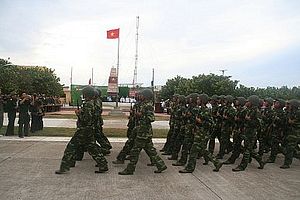Last week, the keel was reportedly laid down for a new landing tank ship for Vietnam. The development highlighted one aspect of Hanoi’s broader, ongoing effort to develop its military capabilities.
As I have noted before in these pages, Vietnam has one of the most capable militaries within Southeast Asia. Some aspects of the Vietnam’s capabilities and military thinking have been periodically highlighted in line with occasional developments, with a case in point being its new defense white paper released last month, the first of its kind in a decade.
Last week, we saw another aspect of Vietnam’s military capabilities on display. Per the defense media outlet IHS Jane’s, the keel was laid down for a landing ship tank on order for Vietnam’s navy last week.
The keel for the 57-meter roll-on/roll-off (Ro-Ro) landing ship tank (LST) for the People’s Army of Vietnam Navy (PAVN) was laid down by Song Thu Corporation, a Vietnamese shipbuilder based in Da Nang, on December 27.
Jane’s said that that the vessel constituted the first such ship acquired for the PAVN, with the vessel, built to a proprietary Damen design, expected to have a length of 57.27 meters, an overall beam of 12 meters, and a maximum draft of 2.75 meters once complete.
No further details were provided on the development by other sources, including Vietnamese state media. But while the laying down of the keel for the LST is reportedly a significant first for the PAVN, it is also in keeping with continuing Vietnamese efforts to develop its capabilities. As an anonymous industry source noted to Jane’s, the vessel is part of ongoing attempts to improve the mobility of Vietnam’s armored units, which the military considers a priority.
The quest for such a capability is not unique to Vietnam and has also been witnessed in other Southeast Asian militaries as well. As I have noted before, countries such as Indonesia have been investing in LSTs in order to increase their mobility, and we have seen ongoing developments with respect to this over the past year.
Until more specifics are disclosed, it is difficult to evaluate the exact impact of what the LST and further investments in this regard will have for Vietnam. But this reported first nonetheless deserves attention given the trends we have been seeing among Southeast Asian militaries as well as Vietnam’s significance as a security actor in its own right.

































